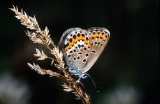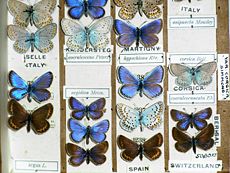
Silver-studded Blue
Encyclopedia
The Silver-studded Blue (Plebejus argus) is a butterfly
in the family Lycaenidae
.
, it is generally slightly smaller and in the male the blue is a darker shade. The Common Blue also has an additional black spot at the base of the underside forewing.
It has suffered severe reduction in its range in the UK due to habitat destruction. Its favoured habitat is heathland and where it is found in the southern strongholds it can still be very numerous. Other habitats include calcerous grassland and dune
s. Apart from its strongholds in the southern heathlands it is also found in scattered colonies in Norfolk
, Suffolk
, Devon
, Cornwall
and Wales
. It is still widespread and locally common across Europe, Asia as far as Japan.

Calluna vulgaris, Bell Heather Erica cinerea, Cross-leaved Heath Erica tetralix and Gorse
s Ulex spp. On grasslands Bird's-foot Trefoil Lotus corniculatus, Common Rock-rose Helianthemum nummularium, Horseshoe Vetch
Hippocrepis comosa and Wild Thyme
Thymus serpyllum are used. The larvae have a close relationship with ants and produce a honeydew
-like liquid to feed them. In return the ants will protect the larvae from predators. Black ants Lasius niger
and Lasius alienus are the two most commonly associated ant species. In some European countries ants have been seen carrying the larvae. Pupation takes near and often inside ant nests where they continue to secrete Honey Dew until the Butterfly emerges. It is single brooded with butterflies on the wing from July until mid August.
Butterfly
A butterfly is a mainly day-flying insect of the order Lepidoptera, which includes the butterflies and moths. Like other holometabolous insects, the butterfly's life cycle consists of four parts: egg, larva, pupa and adult. Most species are diurnal. Butterflies have large, often brightly coloured...
in the family Lycaenidae
Lycaenidae
The Lycaenidae are the second-largest family of butterflies, with about 6000 species worldwide, whose members are also called gossamer-winged butterflies...
.
Appearance, behavior and distribution
So named due to the silvery blue metallic spots on the underside hind wings. The upperside are a rich, deep iridescent blue in the males with a black border and the characteristic Lycid white fringe. on the hindwings there is a row of inconspicuous black spots along the bottom edge. Females are dark brown with orange spots at the edges. On some sites the female has blue colouration but never as extensive as the male and she always possesses the orange spots. The undersides are a typical "Blue" design. The ground colour is silvery grey with blue suffusion at the base of the wings in the male and brown in the female. There are a number of black spots, each outlined in white and a row of orange spots along the outer edge of the hindwings, extending onto the forwings in the female. It is next to these orange spots that the "silver-studs" can be seen. Most easily confused with the Common BlueCommon Blue
The Common Blue is a small butterfly in the family Lycaenidae, widespread over much of the Palaearctic. Recently, Polyommatus icarus was discovered in Mirabel, Quebec, Canada by Ara Sarafian, an amateur entomologist who observed the butterfly from 2005 to 2008...
, it is generally slightly smaller and in the male the blue is a darker shade. The Common Blue also has an additional black spot at the base of the underside forewing.
It has suffered severe reduction in its range in the UK due to habitat destruction. Its favoured habitat is heathland and where it is found in the southern strongholds it can still be very numerous. Other habitats include calcerous grassland and dune
Dune
In physical geography, a dune is a hill of sand built by wind. Dunes occur in different forms and sizes, formed by interaction with the wind. Most kinds of dunes are longer on the windward side where the sand is pushed up the dune and have a shorter "slip face" in the lee of the wind...
s. Apart from its strongholds in the southern heathlands it is also found in scattered colonies in Norfolk
Norfolk
Norfolk is a low-lying county in the East of England. It has borders with Lincolnshire to the west, Cambridgeshire to the west and southwest and Suffolk to the south. Its northern and eastern boundaries are the North Sea coast and to the north-west the county is bordered by The Wash. The county...
, Suffolk
Suffolk
Suffolk is a non-metropolitan county of historic origin in East Anglia, England. It has borders with Norfolk to the north, Cambridgeshire to the west and Essex to the south. The North Sea lies to the east...
, Devon
Devon
Devon is a large county in southwestern England. The county is sometimes referred to as Devonshire, although the term is rarely used inside the county itself as the county has never been officially "shired", it often indicates a traditional or historical context.The county shares borders with...
, Cornwall
Cornwall
Cornwall is a unitary authority and ceremonial county of England, within the United Kingdom. It is bordered to the north and west by the Celtic Sea, to the south by the English Channel, and to the east by the county of Devon, over the River Tamar. Cornwall has a population of , and covers an area of...
and Wales
Wales
Wales is a country that is part of the United Kingdom and the island of Great Britain, bordered by England to its east and the Atlantic Ocean and Irish Sea to its west. It has a population of three million, and a total area of 20,779 km²...
. It is still widespread and locally common across Europe, Asia as far as Japan.

Lifecycle and foodplants
Eggs are laid on or near the ground, often near Ants nests and pass through the winter hatching in the spring in late March or early April. They have a wide variety of foodplants; on heathland the favourites include HeatherCalluna
Calluna vulgaris is the sole species in the genus Calluna in the family Ericaceae. It is a low-growing perennial shrub growing to tall, or rarely to and taller, and is found widely in Europe and Asia Minor on acidic soils in open sunny situations and in moderate shade...
Calluna vulgaris, Bell Heather Erica cinerea, Cross-leaved Heath Erica tetralix and Gorse
Gorse
Gorse, furze, furse or whin is a genus of about 20 plant species of thorny evergreen shrubs in the subfamily Faboideae of the pea family Fabaceae, native to western Europe and northwest Africa, with the majority of species in Iberia.Gorse is closely related to the brooms, and like them, has green...
s Ulex spp. On grasslands Bird's-foot Trefoil Lotus corniculatus, Common Rock-rose Helianthemum nummularium, Horseshoe Vetch
Horseshoe Vetch
Hippocrepis comosa, known as Horseshoe Vetch, is a flowering plant. It is the sole food of the butterfly species Polyommatus coridon, or the Chalkhill Blue....
Hippocrepis comosa and Wild Thyme
Wild thyme
Thymus serpyllum, known by the common names of Breckland Thyme, Wild Thyme or Creeping Thyme is a species of thyme native to most of Europe and North Africa. It is a low, usually prostrate subshrub growing to 2 cm tall with creeping stems up to 10 cm long, with oval evergreen leaves...
Thymus serpyllum are used. The larvae have a close relationship with ants and produce a honeydew
Honeydew (secretion)
Honeydew is a sugar-rich sticky liquid, secreted by aphids and some scale insects as they feed on plant sap. When their mouthpart penetrates the phloem, the sugary, high-pressure liquid is forced out of the gut's terminal opening. Honeydew is particularly common as a secretion in the Hemipteran...
-like liquid to feed them. In return the ants will protect the larvae from predators. Black ants Lasius niger
Black garden ant
The black garden ant is a formicine ant, the type species of the subgenus Lasius, found all over Europe and in some parts of North America and Asia. It is monogynous, meaning colonies have a single queen....
and Lasius alienus are the two most commonly associated ant species. In some European countries ants have been seen carrying the larvae. Pupation takes near and often inside ant nests where they continue to secrete Honey Dew until the Butterfly emerges. It is single brooded with butterflies on the wing from July until mid August.

